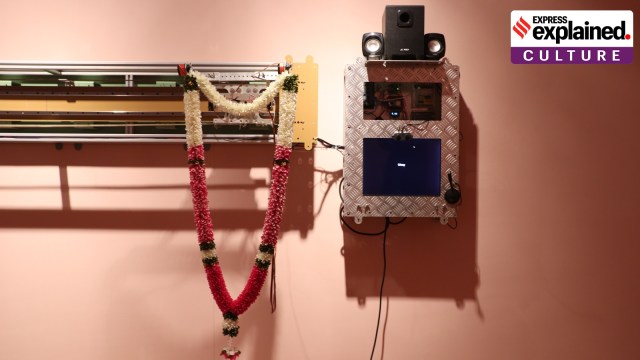Goa’s Serendipity Arts Festival features ‘interactive art’ exhibitions: Everything you need to know about the genre
The roots of interactive art go back to the early 20th Century when surrealist artists such as Salvador Dali and Joan Miro challenged conventional notions of art
 Artist Shailesh BR uses AI in the mechanism of his installation Let’s Make A Choice (Swayamvara) that seeks a partner for marriage. (Photo: Serendipity Arts Festival)
Artist Shailesh BR uses AI in the mechanism of his installation Let’s Make A Choice (Swayamvara) that seeks a partner for marriage. (Photo: Serendipity Arts Festival)Once meant to be admired from a distance, art now is seeking viewer participation in its very creation. The genre of interactive art is reshaping how viewers engage with artworks, responding to their prompts, their presence or movements.
It was in focus at the recent Serendipity Arts Festival in Goa, where the exhibition “Multiplay”, curated by artist duo Sumir Tagra and Jiten Thukral, comprised artworks that fall within the realm of the genre, “blurring the conventional boundaries of the artist and audience.”
Here is a look at the history of the genre, its evolution, and the impact of technological advancements.
What is interactive art?
Interactive art is a type of art that requires intervention of viewers — they can control or dictate the course of artwork. The approach transforms static artworks into evolving pieces that respond to live inputs or actions. This could be through diverse ways, from manual intervention to use of sensors, processing software to Artificial Intelligence, among others.
How did interactive art originate?
The roots of interactive art go back to the early 20th Century when surrealist artists such as Salvador Dali and Joan Miro challenged conventional notions of art. And dadaists like Marcel Duchamp created “readymades” where everyday objects such bicycle wheels and wine bottle racks were elevated to the status of an artwork.
For instance, Duchamp’s 1920 “Rotary Glass Plates”, comprised a machine that used a motor to spin rectangular pieces of glass that had fragments of circles painted on them. When the metal rod was turned on, it made an optical illusion of full circles.
While the ’50s and ’60s saw artists such as Alexander Calder, Fritz Glarner, and Jean Tinguely produce kinetic artworks that responded to motion, the following decades saw the emergence of participatory art forms such as performance art and installation art with proponents such as Yoko Ono and Allan Kaprow.
Ono’s 1964 book Grapefruit, for instance, comprised “event scores” and ideas that replaced the physical work of art, and that viewers could enact if they so wished. Kaprow’s 1961 Yard featured hundreds of used tyres spread in a garden, which visitors had to traverse.
What has been the role of digital technology?
With the arrival of personal computers, ’70s saw artists using computer graphics in their artwork. Gradually, virtual reality and interactive interfaces began to be integrated, leading to works such as Jeffrey Shaw’s 1989 The Legible City, where viewers used a stationary bicycle to travel in a virtual city.
Char Davies’ 1995 virtual reality immersive installation Osmose used 3D computer graphics, interactive sound and real-time motion tracking based on breathing and balance. The art collective JODI (Joan Heemskerk and Dirk Paesmans) experimented with web-based art in the mid ’90s.
The advent of AI-led to further changes, with artists relying on generative AI, such as ChatGPT, DALL-E and other machine learning models, using various algorithms to produce works that respond to audience inputs.
The 2019 exhibition “AI: More than Human” at London’s Barbican Centre was dedicated to artworks that made use of AI. The interactive installations included Rafael Lozano-Hemmer’s Pulse Room, where viewers’ heartbeats influenced light intensity in the area. Hito Steyerl’s Power Plants responded to visitors’ movements through AI analysis.
The recent Serendipity Arts Festival in Goa had, among others, artist Shailesh BR use AI in the mechanism of his installation Let’s Make A Choice (Swayamvara), which was seeking a partner for marriage. It posed a set of questions to prospective spouses, to analyse if they were the right match. Those approved returned home with a garland. In Himanshu Shani’s immersive room visitors were asked to wear coverings on their shoes and then step into indigo paste. They left their footprints as they walked on a white fabric spread on the floor. While Shani intends to design products with these eventually, the process of extracting indigo was also displayed.
- 01
- 02
- 03
- 04
- 05






































